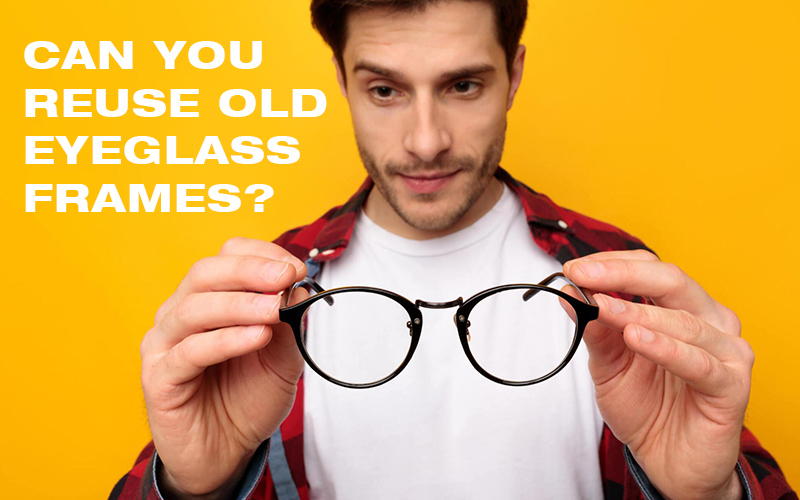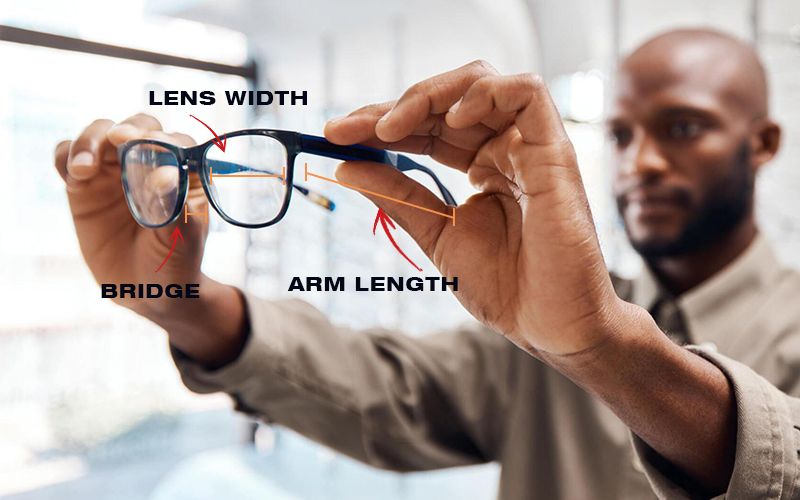
Can You Reuse Old Eyeglass Frames? Find Out Here!
Do you wear optical glasses and want to change your style without spending a lot of money? Or maybe you found an old pair of frames and want to know if you can use them again. Whether it’s for fashion or because you need them, people often wonder if they can reuse old eyeglass frames. In this article, we’ll look at the possibilities and things to think about when it comes to reusing old frames. This way, you can decide what to do with your eyewear.

Can You Reuse Old Eyeglass Frames?
Old eyeglass frames in good condition can be reused. If there are no signs of damage or weakening, they can potentially be paired with new lenses. To do this, first carefully inspect the frames to ensure they are structurally sound, without cracks or excessive wear. Check if they fit the new lenses. If the frames pass these checks, a licensed optician can proceed to fit new lenses into the existing frames. This involves precise measurement and shaping of the lenses to fit correctly.
This process allows for the effective reuse of old eyeglass frames with new lenses, offering both cost savings and resource conservation.
Checking Frame Condition Before Reuse

Look for Damage
Inspecting eyeglass frames for damage is an important step. Look for visible signs of damage like cracks, scratches, or dents. Check the hinges and screws to ensure they work properly. Test the flexibility and strength of these components to avoid potential issues in the future. Consider the fit of the frames and if they still provide a comfortable and secure fit. A proper fit is important for both effectiveness and comfort. Assess these factors to determine if the frames are suitable for reuse.
Test Hinges and Screws
When you want to reuse old eyeglass frames, make sure to test the hinges and screws. Gently open and close the frames to check for loose hinges or unusual noises. Inspect the screws for corrosion, wear, or damage. If the frames pass these tests, they can potentially be reused. However, reusing frames with damaged hinges or screws can cause issues like an unstable fit, increased risk of breakage, or discomfort for the wearer.
It’s important to carefully assess the condition of the hinges and screws before reusing old eyeglass frames. You can consult with a professional optician or eyeglass repair specialist to check if frames with hinge or screw issues can be reused.
Check the Fit
When thinking about reusing old eyeglass frames, it’s important to check the fit first. Comparing the measurements of the old frames to the new ones can help determine if they are a good fit. Additionally, trying on the old frames and paying attention to how they sit on the face can also help decide if they are suitable for reuse. When considering reusing old lenses with new frames, it’s important to ensure a proper fit. This involves making sure that the lens shape matches the new frames and checking for any signs of damage or wear.
In deciding whether to reuse old frames or purchase new ones, individuals should consider factors such as the condition of the old frames, their durability, and the availability of replacement parts. By carefully assessing the fit and condition of old eyeglass frames, individuals can make an informed decision about whether to reuse them or opt for new frames.
Understanding Prescription Changes

When getting new lenses for your glasses, start by getting the latest prescription from your eye doctor. It’s important to know the measurements of your frames to check if they work with the new prescription. If the prescription changes a lot or needs a different lens size or shape, you might need new frames. Before using old frames again, make sure they match the new prescription. Talk to an optician to double-check.
When to Get New Frames?
It may be time to consider getting new frames for your eyeglasses if you notice that your current frames are becoming loose, uncomfortable, or have visible signs of damage.
Signs that may indicate it’s time for new frames include:
- Crooked or misshapen frames
- Discolored or peeling coating
- Missing screws
- Frames that no longer fit properly or cause irritation behind the ears or on the nose
It’s a good idea to have your frames checked for wear and tear at least once a year, or more frequently if you notice any of the signs mentioned above. Keeping an eye on the condition of your frames can help prevent discomfort and ensure the longevity of your eyeglasses.
Can You Reuse Eyeglass Frames with New Lenses?
Find Out Lens Compatibility
When you want to reuse eyeglass frames, first make sure the lenses are compatible with the frames. You can take the frames to an optician to check. They can assess the frames and tell you if they can work with new lenses. It’s also important to check that the frames are not damaged or misshapen, as this affects whether old lenses can be used in new frames. When reusing frames, consider their size, shape, and the type of lenses needed.
Not all frames fit all types of lenses, so it’s best to get advice from a professional for the right fit and compatibility.
Ask an Eye Specialist
Yes, old eyeglass frames can be reused with new lenses. When a person’s prescription changes, they may need new frames for the updated prescription. But often, existing frames can have new lenses put in, saving the cost of buying a new frame. This is helpful when the frames are in good condition and still fit well. It’s important to check with an eye specialist to make sure the frames work with new lenses.
Sometimes, the shape, size, or material of the frames may not work with the new prescription. Reusing eyeglass frames with new lenses can be a practical and cost-effective choice for people who need to update their prescription.
Weighing Benefits of Reuse vs. New
When deciding whether to reuse old eyeglass frames or buy new ones, it’s important to consider potential repair and adjustment costs. Assess the condition of the old lenses to see if they can be used with a new prescription. Also, check the old frames and hinges to determine if they can be reused or if it’s better to get new frames.
These factors help weigh the benefits of reusing frames against buying new ones, allowing individuals to make an informed decision without mentioning specific brandnames.
How to Tell if Old Lenses Can Be Reused
Assess Lens Condition
When checking eyeglass frames, it’s important to inspect the lenses closely. Look for scratches, cracks, or discoloration. These may mean the lenses can’t be used anymore. Also, check for any warping or deterioration. This can affect the quality of the lenses. If the lenses are okay, make sure they work with your new prescription. It’s best to ask an eyewear professional about reusing old lenses. They can give helpful advice based on the condition and type of lenses.
By examining the lenses andgetting professional advice, you can make a smart choice about reusing your eyeglass frames.
Understanding Lens Technology Advances
Advances in lens technology have greatly improved vision and comfort for eyeglass wearers. Features like anti-reflective coatings, digital lens designs, and blue light filtering capabilities can enhance visual clarity, reduce digital eye strain, and provide better protection against UV rays.
Reusing old frames with new lenses is now a more feasible option due to the flexibility of lens materials and coating options available. When deciding between reusing old frames with new lenses or opting for new frames, factors to consider include the condition and style of the old frames, compatibility with new lens designs, and personal preferences for frame aesthetics.
With these advancements, individuals now have the option to update their eyeglasses with the latest features without needing to invest in entirely new frames.
Steps to Reuse Your Existing Frames
- Remove Old Lenses
When considering reusing eyeglass frames, you can check if the old lenses have any damage, scratches, or deterioration. If the lenses are in good condition without these issues, they may be suitable for reuse.
To remove old lenses from eyeglass frames, you can carefully pop them out using a small, pointed tool. Alternatively, you can visit an optician for professional removal. Once the old lenses are removed, the frames can often be reused with new lenses, as long as they are still in good condition without any damage or warping.
Reusing frames with new lenses can be a cost-effective and sustainable option, especially for those who have favorite frames they want to continue using while updating their prescription.
- Fit New Lenses
Yes, you can use old frames with new lenses. This can be helpful if your frames are still in good condition and you want to keep using them. Check the old lenses for scratches or damage to see if they can be reused with new lenses. Make sure the old lenses match the size and shape of the frames. If your prescription has changed, the new lenses will need to match your current prescription. Consult an eye care professional to ensure the new lenses are aligned with your updated prescription.
This will maintain good vision and prevent discomfort from wearing glasses with the wrong prescription.
- Final Adjustments for Eyes
It’s important to consult with an optometrist when considering reusing old lenses for existing frames. The optometrist will evaluate the condition of the old frames and lenses to ensure they are suitable for reuse.
When making final adjustments for eyes with new lenses in existing frames, the optometrist will consider the prescription requirements, the fit of the new lenses in the old frames, and any necessary repairs or modifications to the frames.
Conclusion
You can reuse old eyeglass frames. There are factors that determine if old frames can be reused. Before repurposing them, consider these factors. Determine if your old frames are still suitable for reuse and explore the options available for repurposing them. To learn more knowledge about eyeglasses, At Optics Town eyeglasses wholesaler.
FAQ
Q: What are the differences between TR90 frames and Acetate frames?
A: TR90 frames are more lightweight and flexible, while acetate frames are more durable and can have more intricate designs. For example, TR90 frames are great for sports and activities, while acetate frames are better for fashion-forward styles.
Q: What are the pros and cons of TR90 frames compared to Acetate frames?
A: Pros of TR90 frames:
Lightweight and flexible, great for active lifestyles.
Hypoallergenic and resistant to temperature changes.
Cons of TR90 frames:
Limited color options compared to acetate.
Less customizable in terms of patterns and textures.
Q: How do TR90 frames and Acetate frames differ in terms of durability and flexibility?
A: TR90 frames are more durable and flexible than Acetate frames. TR90 is a thermoplastic material that is lightweight and resistant to damage from bending or twisting. Acetate frames are less flexible and can easily break or crack.
Q: Which type of frame material is best for people with sensitive skin or allergies?
A: Titanium is the best frame material for people with sensitive skin or allergies. It is hypoallergenic and lightweight, making it a great option for those with skin sensitivities.
Q: What factors should I consider when choosing between TR90 and Acetate frames?
A: When choosing between TR90 and Acetate frames, consider factors like durability, flexibility, and weight. TR90 is lightweight and flexible, while Acetate is more durable and offers a wide range of color options. Consider your lifestyle and preferences when making a decision.




